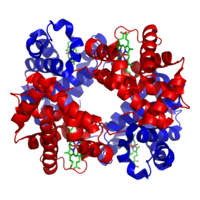
Photo from wikipedia
Hydrogenases are appealing catalysts for fuel cells, as these highly efficient H2-oxidation enzymes do not contain expensive precious metals and operate under very mild and safe conditions. Unfortunately, [FeFe] hydrogenases… Click to show full abstract
Hydrogenases are appealing catalysts for fuel cells, as these highly efficient H2-oxidation enzymes do not contain expensive precious metals and operate under very mild and safe conditions. Unfortunately, [FeFe] hydrogenases — the most active class — are irreversibly deactivated by O2. This activity loss is associated with access of O2 to the active centre, which displays an open coordination site at its FeS cluster. Now, Olaf Rüdiger, James Birrell and co-workers report a simple protocol that allows handling oxygen-sensitive hydrogenases in the presence of air without activity loss by reversible coordination of a presumed HS− ligand to the open coordination site of the FeS cluster. The approach is simple, merely requiring chemical treatment of the enzyme with oxidizing agent hexaammineruthenium(iii) chloride (HAR) and Na2S. Based on spectroscopic and electrochemical experiments as well as previous literature reports, the authors propose a mechanism for this reversible protection. Excess of Na2S in solution provides H2S. H2S binds to the free coordination site of oxidized hydrogenase (Hox). Reduction of the enzyme from excess of sulfide and concomitant release of the H2S ligand is prevented by the oxidizing agent HAR. The amine functionality of the FeS cluster then deprotonates the coordinated H2S moiety yielding the HS− ligand. Subsequently, the enzyme goes through a transition state by intramolecular electron transfer coupled to deprotonation of the cluster’s amine group. Finally, an oxidization step by HAR or air yields the oxygen-stable Hox state. The oxygen-stable enzyme can then be handled in the presence of air, which has the potential to alleviate the preparation of [FeFe]hydrogenase-employing fuel cells and other biocatalytic devices. The native active Hox state can be restored, for example, by treatment with Na2S2O4 and subsequent reoxidation with HAR. Importantly, a redox hydrogel has been previously reported allowing the protection of [FeFe] hydrogenases from O2 and highpotential inactivation in fuel cells. The provided simple protocol for handling [FeFe] hydrogenases in the presence of air makes their implementation in biotechnological applications more feasible and will probably motivate more researchers to work with this appealing enzyme class.
Journal Title: Nature Catalysis
Year Published: 2018
Link to full text (if available)
Share on Social Media: Sign Up to like & get
recommendations!